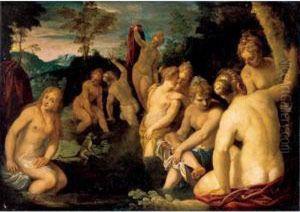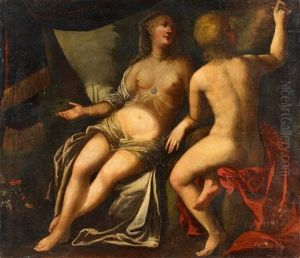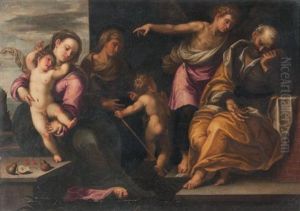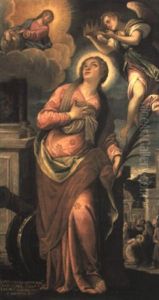Maffeo Verona Paintings
Maffeo Verona, born in 1585 in Verona, Italy, was a distinguished painter of the early Baroque period, whose work contributed to the artistic transitions of his time. Though not as widely known as some of his contemporaries, Verona's contributions to the Baroque movement are notable for their dynamic compositions, vibrant use of color, and emotional depth. His artistic journey reflects the broader shifts in European art from the late Renaissance through the early stages of Baroque, emphasizing a move towards more dramatic and expressive forms.
Growing up in Verona, a city with a rich artistic heritage, Maffeo was exposed to the works of earlier Renaissance masters, which influenced his early development as a painter. However, as he matured, his style evolved, showing a clear departure from the serene and balanced compositions of the Renaissance towards the more dynamic and emotionally charged approach characteristic of Baroque art. Verona's paintings often depicted religious themes, common for the period, with a particular focus on scenes from the New Testament. His works are distinguished by their dramatic lighting, a technique that would later be associated with tenebrism, though Verona's approach was generally more moderate compared to artists like Caravaggio.
Despite his talents, Maffeo Verona's career was marked by the challenges of competing with more prominent figures of his time. Nevertheless, he managed to secure commissions from several important churches and patrons in Verona and the surrounding regions, contributing significantly to the local artistic landscape. His altarpieces and frescoes, adorned with his signature vibrancy and emotional intensity, can still be seen in various churches and galleries, offering a glimpse into the transitionary period of European art that Verona inhabited.
Maffeo Verona's death in 1638 marked the end of a career that, while perhaps not as celebrated as some of his peers, played a crucial role in the development of Baroque art in Italy. His legacy, though overshadowed by the likes of Caravaggio and Bernini, remains an important chapter in the history of Italian art, reflecting the nuanced and often overlooked contributions of artists who bridged the gap between the Renaissance and Baroque periods. Through his works, Verona continues to offer insights into the evolving aesthetic sensibilities and cultural priorities of early 17th-century Italy.



